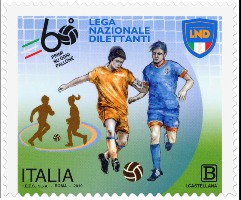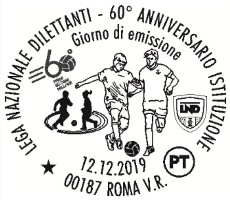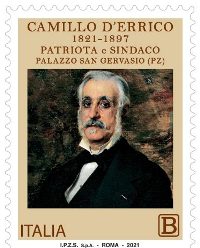POSTE ITALIANE 69^ emissione del 12 Dicembre 2019 di un francobollo dedicato alla Lega Nazionale Dilettanti, nel 60° anniversario della istituzione
POSTE ITALIANE 69^ emissione del 12 Dicembre 2019 di un francobollo dedicato alla Lega Nazionale Dilettanti, nel 60° anniversario della istituzione


Il Ministero dello Sviluppo ha emesso il 12 dicembre 2019 un francobollo ordinario appartenente alla serie tematica “lo Sport” dedicato alla Lega Nazionale Dilettanti, nel 60° anniversario della istituzione, relativo al valore della tariffa B, corrispondente ad €1.10.
- data / date 11 dicembre 2019
- dentellatura / serration 11
- stampa / printing rotocalcografia
- tipo di carta / paper type carta patinata gommata, adesiva
- stampato / printed I.P.Z.S. Roma
- tiratura / edition 500.000
- fogli / sheet 28
- dimensioni / dimension 48 x 40 mm
- costo / price B = € 1,10
- bozzettista/ designer Isabella Castellana
- num. catalogo/catalog num. Michel 4182 YT 3943 UN

La Lega Nazionale Dilettanti (LND) è l’organo che dirige e organizza, tramite i suoi comitati interni, i campionati e le coppe per le squadre maschili iscritte dal quarto fino all’ultimo livello del calcio italiano e i campionati femminili di Serie C, Eccellenza e Promozione e le manifestazioni del beach soccer e del Calcio a 5. Fu fondata nel 1959 e ha sede a Roma.
Storia
La Lega Nazionale Dilettanti nacque il 2 agosto 1959, in seguito alla riforma Zauli: alla Lega Nazionale Dilettanti fu assegnata la coordinazione dei campionati locali di Prima, Seconda e Terza Categoria gestiti, come al solito, dai Comitati Regionali, che prima di allora dipendevano direttamente dalla FIGC. Il primo presidente della L.N.D. fu l’ingegnere Ottorino Barassi, in passato anche Presidente della FIGC.
Tra il 1960 e il 1964 la Lega Nazionale Dilettanti affrontò con successo le competenze un tempo della FIGC e ora a lei affidate, come il coordinamento dei Campionati Regionali gestiti dai Comitati Regionali e l’impiantistica sportiva: nel giro di due anni l’attività agonistica tra i Dilettanti era aumentata di oltre il 50%. Nel 1962 venne costituita la squadra nazionale dilettante, la quale ben si comportò al primo Torneo Internazionale a cui prese parte, svoltosi in Inghilterra. Nel 1964 uscì il primo numero della rivista ufficiale della L.N.D., “Calcio Dilettanti”, a cui collaborò persino Luciano Barra, che poi avrebbe fatto carriera nel CONI. Nello stesso anno il Presidente della FIGC, Pasquale, propose di rendere di nomina i Presidenti dei Comitati Regionali, ma di fronte alle opposizioni, fu costretto a non attuare la sua proposta.
La prima assemblea della L.N.D. si tenne nei primi mesi del 1965, e vi parteciparono oltre il 90% delle affiliate alla Lega, un numero intorno alle 2.000 unità. Nel 1967 fu introdotto il Campionato di Promozione e si svolse la prima edizione della Coppa Italia Dilettanti, la cui vincente, in teoria, si sarebbe qualificata a una competizione anglo-italiana in cui avrebbe affrontato in una doppia finale la vincente della Coppa Dilettanti Inglese: tale competizione durò per parecchi decenni, per poi essere soppressa. Nel frattempo la Lega dovette affrontare il problema dell’aumento delle squadre iscritte che aumentavano di anno in anno (dalle 2.000 squadre affiliate si passò a oltre 6.000 nel 1971) e della regolarità dei campionati.
Dopo la dipartita di Barassi nel 1971, venne eletto Presidente della Lega Artemio Franchi, il quale mantenne la carica fino al 1978, allorché divenne presidente della FIGC. Fu sostituito da Antonio Ricchieri, eletto dopo una turbolenta elezione, fu alla presidenza della Lega per nove anni, nel corso dei quali si verificò un aumento delle società e degli atleti tesserati: dalle 6.000 squadre affiliate (1971) si era passati alle oltre 9.000 (1978) mentre i calciatori dilettanti passarono dai 100.000 ai 600.000 atleti (1978).
Nel 1981 la Lega Nazionale Semiprofessionisti, che gestiva i campionati di Serie C1, Serie C2 e Serie D, fu soppressa e sostituita dalla Lega Nazionale Serie C, che era professionistica e gestiva i campionati di Serie C1 e C2. Conseguenza della riforma fu la soppressione della Serie D semiprofessionistica, sostituita dal Campionato Interregionale affidato alla gestione della Lega Nazionale Dilettanti.
La L.N.D. gestiva un campionato non regionale bensì interregionale, le cui vincenti sarebbero state promosse nei campionati professionistici, ma nel farlo non lo fece direttamente, lo fece istituendo nel 1981 il “Comitato per l’attività Interregionale” avente sede a Roma in Via Tevere 11. Negli anni successivi la Lega Nazionale Dilettanti cominciò a gestire il campionato nazionale di Calcio a 5, nonché il campionato italiano di calcio femminile, mentre le società affiliate alla Lega erano arrivate a superare le 10.000 unità.
Nel 1987 fu eletto Presidente della Lega Nazionale Dilettanti Elio Giulivi, che mantenne la carica fino al 1998. Nel 1990 la L.N.D. decise di istituire il Campionato “Amatori” per andare incontro alle persone che per motivi lavorativi o di età, erano impossibilitati a svolgere un’attività agonistica ma che comunque ambivano a praticare comunque lo sport.
Nel 1998, in seguito a una diatriba giuridica dovuta al risultato di una gara, il Presidente della L.N.D. Giulivi venne inibito per un anno e la stessa L.N.D. finì per essere commissariata. Giulivi venne sostituito nel 1999 da Carlo Tavecchio, che in passato era stato Presidente del Comitato Regionale Lombardia. Vennero eletti inoltre tre Vicepresidenti, ognuno rappresentante le tre aree geografiche dell’Italia: il Nord, il Centro e il Sud.
Se sei interessato all’acquisto di questo francobollo lo puoi acquistare al prezzo di €1.50. Inviami una richiesta alla email: protofilia1@gmail.com
POSTE ITALIANE 69th issue of 12 December 2019 of a stamp dedicated to the National Amateur League, on the 60th anniversary of the institution

- data / date 11 dicembre 2019
- dentellatura / serration 11
- stampa / printing rotocalcografia
- tipo di carta / paper type carta patinata gommata, adesiva
- stampato / printed I.P.Z.S. Roma
- tiratura / edition 500.000
- fogli / sheet 28
- dimensioni / dimension 48 x 40 mm
- costo / price B = € 1,10
- bozzettista/ designer Isabella Castellana
- num. catalogo/catalog num. Michel 4182 YT 3942 UN
The National Amateur League (LND) is the body that directs and organizes, through its internal committees, the championships and cups for the men’s teams entered from the fourth to the last level of Italian football and the women’s Serie C, Excellence and Promotion and events of beach soccer and 5-a-side football. It was founded in 1959 and is based in Rome.
History
The National Amateur League was born on August 2, 1959, following the Zauli reform: the National Amateur League was assigned the coordination of the local First, Second and Third Category championships managed, as usual, by the Regional Committees, which before then depended directly on by the FIGC. The first president of the L.N.D. it was the engineer Ottorino Barassi, in the past also President of the FIGC.
Between 1960 and 1964, the National Amateur League successfully faced the competencies of the FIGC and now entrusted to it, such as the coordination of the Regional Championships managed by the Regional Committees and the sports facilities: within two years the competitive activity among the Amateurs it had increased by over 50%. In 1962 the national amateur team was formed, which performed well at the first International Tournament in which it took part, which took place in England. In 1964 the first issue of the official journal of the L.N.D., “Calcio Dilettanti”, was released, to which even Luciano Barra, who would later make a career in CONI, collaborated. In the same year, the President of the FIGC, Pasquale, proposed to nominate the Presidents of the Regional Committees, but faced with the opposition, he was forced not to implement his proposal.
The first assembly of the L.N.D. it was held in the first months of 1965, and over 90% of the Lega affiliates participated, a number of around 2,000. In 1967 the Promotion Championship was introduced and the first edition of the Amateur Italian Cup was held, whose winner, in theory, would have qualified for an Anglo-Italian competition in which it would have faced the winner of the English Amateur Cup in a double final: this competition lasted for several decades, only to be suppressed. In the meantime the League had to face the problem of the increase in registered teams which increased year by year (from the 2,000 affiliated teams to over 6,000 in 1971) and the regularity of the championships.
After Barassi’s departure in 1971, he was elected President of the League Artemio Franchi, who held the office until 1978, when he became president of the FIGC. He was replaced by Antonio Ricchieri, elected after a turbulent election. He was the president of the League for nine years, during which there was an increase in the number of companies and registered athletes: from the 6,000 affiliated teams (1971) they had gone over 9,000 ( 1978) while the amateur footballers went from 100,000 to 600,000 athletes (1978).
In 1981 the National Semi-Professional League, which ran the Serie C1, Serie C2 and Serie D championships, was suppressed and replaced by the Lega Nazionale Serie C, which was professional and managed the Serie C1 and C2 championships. The consequence of the reform was the suppression of the semi-professional D Series, replaced by the Interregional Championship entrusted to the management of the National Amateur League.
The L.N.D. he managed a non-regional championship but interregional, whose winners would be promoted in the professional leagues, but in doing so he did not do so directly, he did so by establishing in 1981 the “Committee for Interregional Activity” based in Rome in Via Tevere 11. In the subsequent years the National Amateur League began to manage the national 5-a-side football championship, as well as the Italian women’s football league, while the League’s affiliated companies had reached over 10,000 units.
In 1987 he was elected President of the National Amateur League Elio Giulivi, who held the office until 1998. In 1990 the L.N.D. he decided to set up the “Amateurs” Championship to meet people who, for work or age reasons, were unable to play an agonistic activity but still aspired to practice sport anyway.
In 1998, following a legal dispute due to the result of a tender, the President of the L.N.D. Giulivi was inhibited for a year and the same L.N.D. ended up being commissioner. Giulivi was replaced in 1999 by Carlo Tavecchio, who had previously been President of the Lombardy Regional Committee. Three Vice-Presidents were also elected, each representing the three geographical areas of Italy: the North, the Center and the South.
If you are interested in buying the stamp you can buy it for € 1.50. Send me a request to the email: protofilia1@gmail.com







